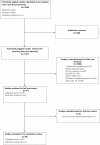Measuring intensity of end of life care: a systematic review
- PMID: 25875471
- PMCID: PMC4396980
- DOI: 10.1371/journal.pone.0123764
Measuring intensity of end of life care: a systematic review
Abstract
Background: Many studies have measured the intensity of end of life care. However, no summary of the measures used in the field is currently available.
Objectives: To summarise features, characteristics of use and reported validity of measures used for evaluating intensity of end of life care.
Methods: This was a systematic review according to PRISMA guidelines. We performed a comprehensive literature search in Ovid Medline, Embase, The Cochrane Library of Systematic Reviews and reference lists published between 1990-2014. Two reviewers independently screened titles, abstracts, full texts and extracted data. Studies were eligible if they used a measure of end of life care intensity, defined as all quantifiable measures describing the type and intensity of medical care administered during the last year of life.
Results: A total of 58 of 1590 potentially eligible studies met our inclusion criteria and were included. The most commonly reported measures were hospitalizations (n = 44), intensive care unit admissions (n = 39) and chemotherapy use (n = 27). Studies measured intensity of care in different timeframes ranging from 48 hours to 12 months. The majority of studies were conducted in cancer patients (n = 31). Only 4 studies included information on validation of the measures used. None evaluated construct validity, while 3 studies considered criterion and 1 study reported both content and criterion validity.
Conclusions: This review provides a synthesis to aid in choosing intensity of end of life care measures based on their previous use but simultaneously highlights the crucial need for more validation studies and consensus in the field.
Conflict of interest statement
Figures
References
-
- Curtis JR, Engelberg RA, Bensink ME, Ramsey SD. End-of-life care in the intensive care unit: can we simultaneously increase quality and reduce costs? American journal of respiratory and critical care medicine. 2012. Oct 1;186(7):587–92. PubMed Pubmed Central PMCID: PMC3480521. Epub 2012/08/04. eng. 10.1164/rccm.201206-1020CP - DOI - PMC - PubMed
-
- Yabroff KR, Warren JL, Brown ML. Costs of cancer care in the USA: a descriptive review. Nature clinical practice Oncology. 2007. Nov;4(11):643–56. PubMed . Epub 2007/10/30. eng. - PubMed
-
- Le Conte P, Baron D, Trewick D, Touze MD, Longo C, Vial I, et al. Withholding and withdrawing life-support therapy in an Emergency Department: prospective survey. Intensive care medicine. 2004. Dec;30(12):2216–21. PubMed . Epub 2004/11/02. eng. - PubMed
-
- van Walraven C, Forster AJ, Parish DC, Dane FC, Chandra KM, Durham MD, et al. Validation of a clinical decision aid to discontinue in-hospital cardiac arrest resuscitations. JAMA: the journal of the American Medical Association. 2001. Mar 28;285(12):1602–6. PubMed . Epub 2001/04/13. eng. - PubMed
Publication types
MeSH terms
Substances
LinkOut - more resources
Full Text Sources
Other Literature Sources
Miscellaneous


